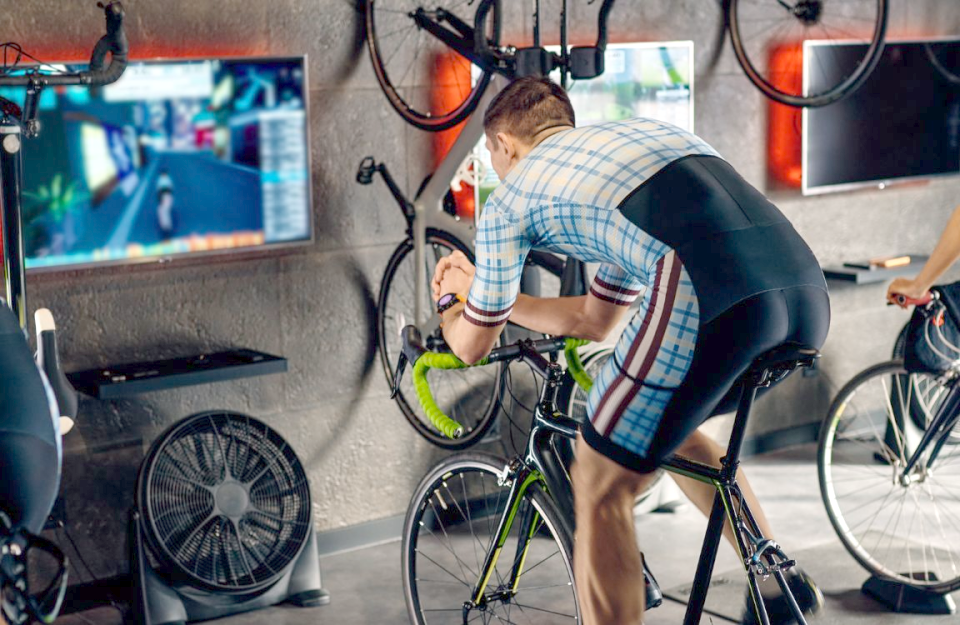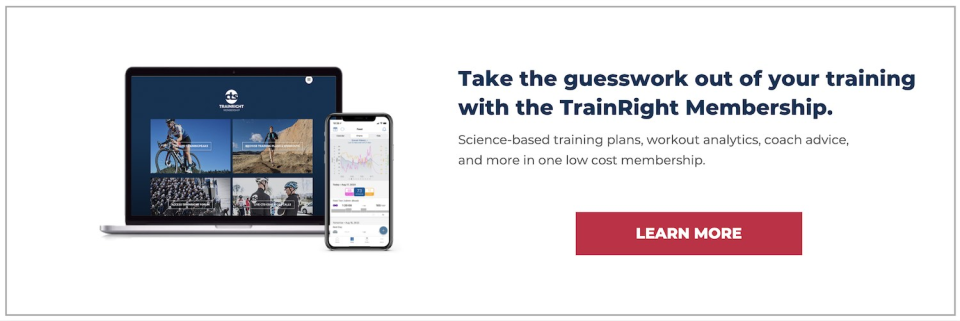5 Tips for Setting Up an Effective Indoor Cycling Space
If indoor cycling is going to be a substantial component of your training time – either for a season or year round – it’s best to create a dedicated space where you can leave the trainer and associated equipment set up between rides

Needing to drag the trainer, fans, bike, etc. out and set them up before every ride is too high a barrier for many. It’s even more labor intensive if you must protect the floor from sweat or you need to reconfigure all the app-to-trainer-to-device connections each time. When setting up your indoor cycling space, use these 5 tips to save time and set yourself up for a more effective and enjoyable experience.
Step 1: Claim Your Space
From a compliance perspective you are more likely to get on the trainer when the environment is inviting and convenient. That means you should try to find a space where you can leave the majority of your indoor training equipment set up and ready to go at a moment’s notice. If you have to drag the trainer, TV, and bike from all over the house every time you want to ride, you’re not going to bother. Similarly, if your space is a dingy, musty corner of the basement or a freezing cold shed in the backyard, getting on the bike won’t be very enticing.
When looking for a space, the minimum requirements include:
- Floor space that measures at least 4 feet by 8 feet, which is only slightly larger than a twin bed.
- At least one electrical outlet. At minimum you need the ability to plug in a fan. If you are using a television, laptop, multiple fans, and a smart trainer you’ll need a power strip or multiple outlets.
- Although you don’t need a lot of floorspace to create an effective indoor cycling setup, a larger or more open space is preferable for airflow.
Step 2: Gather Your Gear
There are a few key items that make indoor training more comfortable and effective:
- Stationary cycling trainer. This can be a direct drive smart trainer, wheel-on smart trainer, traditional resistance trainer, rollers, or a smart bike.
- Front wheel block and/or mechanism to change the height of the front wheel. Most times you’ll want the front and rear axles to be level, but for some workouts you may want to simulate your climbing position on the bike by raising the front wheel even higher. You can also use equipment that adjusts the angle the bike based on a virtual course.
- Fan. One will work, two is even better.
- Devices. If you are using a smart trainer you will need a device (Apple TV, laptop, tablet, smartphone) with an app that can connect to and control the smart trainer. Depending on how much attention is required to complete your workout, you may also want a separate device for entertainment.
- Bar Stool or indoor cycling desk. Somewhere to put the remote, snacks, water, towels, etc. where you can still reach them.
- Towels. One small one for wiping your face, one bigger one to catch dripping sweat.
- Bicycle. The rest of the gear won’t do you much good without it. Make sure to put two full bottles in the cages.
Step 3: Protect your space and equipment
If you set up your indoor cycling space in a room with carpet, put a waterproof mat under the bike. When training in a room with a hard floor (concrete, hardwood, laminate, tile) use either a waterproof mat or an absorbent towel/rag to at least reduce cleaning time. Don’t leave a wet towel or puddle of sweat on a hardwood floor.
The floor isn’t the only thing you have to protect from sweat, nor is it the most important. Salty sweat is corrosive to all the metal parts on your bicycle or indoor cycle, to varying extents. Wiping sweat off your bike, or using an absorbent ‘sweat net’ that catches sweat before it drips onto your frame, minimizes much of this corrosion. Don’t forget the headset and bottom bracket; sweat can seep in and degrade lubricant and damage the metal components of cartridge bearings. Sweat can also corrode aluminum handlebars under the handlebar tape, which is particular problem for dedicated indoor bikes. And keep an eye on stem and headset bolts, as they routinely get soaked in sweat during indoor rides.
Step 4: Choose your training content and entertainment
Most people set their trainer up facing a screen so they can view Zwift, Rouvy, Fulgaz, or their favorite training app, or to watch training videos, television shows, sporting events, or footage of the Tour de France and other races. One key to riding in comfort and simulating your outdoor riding position is to position the screen low and at least six feet in front of your front wheel. You don’t want the screen up so high you have to sit up or hyperextend your neck to see it. If you’re using a TV, that often means taking it off a stand, which allows you to watch while keeping your head, neck, and shoulders in the position you normally use outside. This is sometimes easier to accomplish using a tablet or laptop rather than a full-sized TV.
When it comes to training content, cyclists have more choices than ever. Using a smart trainer or a traditional resistance trainer with a power meter, you can use structured workouts, ride video or gamified courses, participate in virtual group rides and e-races, or just do your own thing. If you choose group rides or e-races, keep in mind you won’t want to get off the bike mid-ride, so make sure you have everything you’ll need within easy reach.
Step 5: Crank Up the Fans
When you ride an indoor trainer in still air, even in a cool or cold room, you superheat a pocket of air immediately surrounding your body and then struggle to keep cool. Moving air is crucial for evaporating the sweat off your body and controlling core temperature; if you’re too hot, your performance suffers and you’re less likely to complete your workout.
If you’re using one fan, place it in front of you and off to the side at about the 10-11 or 1-2 o’clock positions. You want to direct the air so it flows over as much of your skin as possible, and from these positions you can get moving air on your face, chest, arms, shoulders, and legs. If you have a second fan, position it behind you so it’s blowing on your back; the big area not being hit from the fan in front.
More Indoor Trainer Tips:
- Close the heater vents. When you’re in there generating a lot of heat and using fans to keep you cool, there’s nothing worse than having the furnace flood the room with more hot air.
- Don’t forget about the drops. If you live in a snowbound area where you’ll be riding the trainer for months at a time, remember to spend some time doing intervals in the drops. If you want to be able to ride powerfully in this position outdoors next spring, you have to spend some time riding in that position now.
- Crack a window. Some cold air from outside will help keep the room and your body cooler while you’re training.
- Consider wireless headphones. If you’re training at night, early in the morning, or in a house with thin walls, you can avoid cranking the volume on your TV by getting some wireless headphones. Then all your family will hear is the trainer… and your agony.
- Level the bike. Unless you’re purposely elevating your front wheel to simulate a climbing position, your bike should be level when it’s on the trainer. With a standard frame, you can check by putting a level on the top tube. With compact frames (sloping top tube), you can measure to make sure both hubs are equidistant from the floor. You should only have to do this once, as long as you’re able to leave the trainer and wheel block in place until your next indoor trainer ride.
By Jim Rutberg,
CTS Pro Coach, co-author of “Ride Inside“, “The Time-Crunched Cyclist”, and “Training Essentials for Ultrarunning”
The above is a short excerpt from the full CTS TrainRight article, to read the full article, please visit: https://trainright.com/5-tips-for-setting-up-an-effective-indoor-cycling-space
FREE 14 DAY MEMBERSHIP TRIAL
Gran Fondo Guide fans, click on the image above and get TrainRight Membership for a 14 day no obligation trial. TrainRight Membership comes with a 30-day money-back guarantee!
About CTS
As it has since 2000, Carmichael Training Systems leads the endurance coaching industry with proven and innovative products, services, and content. And the results speak for themselves; no other coaching company produces more champions, in such a wide variety of sports and age groups, than CTS.
For more information, please visit: https://trainright.com

